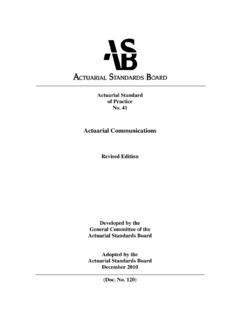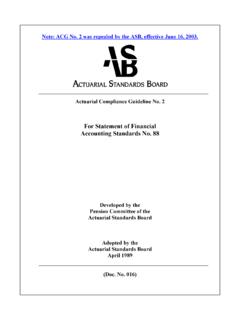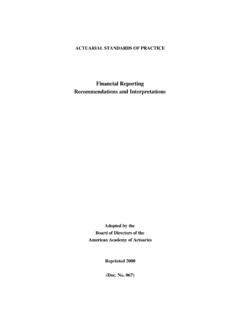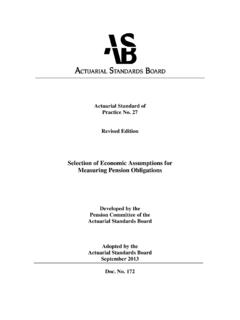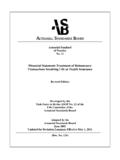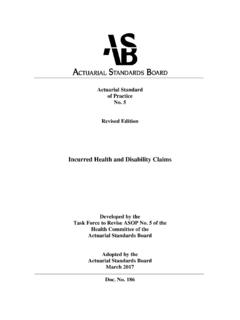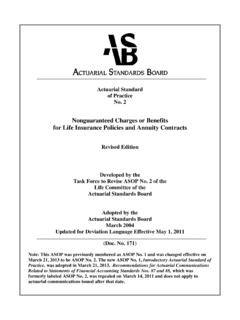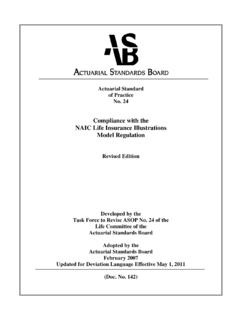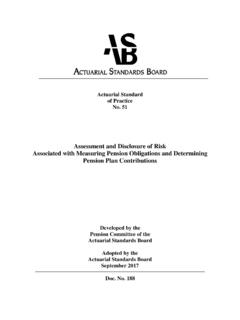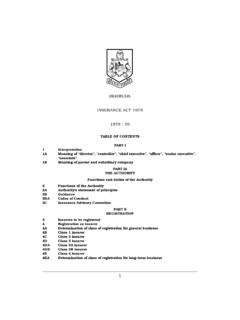Transcription of Risk Classification (for All Practice Areas)
1 actuarial Standard of Practice No. 12. Risk Classification (for All Practice Areas). Revised Edition Developed by the Task Force to Revise ASOP No. 12 of the General Committee of the actuarial standards Board Adopted by the actuarial standards Board December 2005. Updated for Deviation Language Effective May 1, 2011. (Doc. No. 132). ASOP No. 12 December 2005. TABLE OF CONTENTS. Transmittal Memorandum iv STANDARD OF Practice . Section 1. Purpose, Scope, Cross References, and Effective Date 1. Purpose 1. Scope 1. Cross References 1. Effective Date 2. Section 2. Definitions 2. Advice 2. Adverse Selection 2. Credibility 2. Financial or Personal Security System 2.
2 Homogeneity 2. Practical 2. Risk(s) 2. Risk Characteristics 2. Risk Class 2. Risk Classification System 3. Section 3. Analysis of Issues and Recommended practices 3. Introduction 3. Considerations in the Selection of Risk Characteristics 3. Relationship of Risk Characteristics and Expected Outcomes 3. Causality 3. Objectivity 4. Practicality 4. Applicable Law 4. Industry practices 4. Business practices 4. Considerations in Establishing Risk Classes 4. Intended Use 4. actuarial Considerations 5. Other Considerations 5. Reasonableness of Results 5. Testing the Risk Classification System 5. Effect of Adverse Selection 5. Risk Classes Used for Testing 6.
3 Effect of Changes 6. Quantitative Analyses 6. ii ASOP No. 12 December 2005. Reliance on Data or Other Information Supplied by Others 6. Documentation 6. Section 4. Communications and Disclosures 7. Communications and Disclosures 7. APPENDIXES. Appendix 1 Background and Current practices 8. Background 8. Current practices 9. Appendix 2 Comments on the Exposure Draft and Responses 10. iii ASOP No. 12 December 2005. December 2005. TO: Members of the American Academy of Actuaries and Other Persons Interested in Risk Classification (for All Practice Areas). FROM: actuarial standards Board (ASB). SUBJ: actuarial Standard of Practice (ASOP) No.
4 12. This booklet contains the final version of a revision of ASOP No. 12, now titled Risk Classification (for All Practice Areas). Background In 1989, the actuarial standards Board adopted the original ASOP No. 12, then titled Concerning Risk Classification . The original ASOP No. 12 was developed as the need for more formal guidance on risk Classification increased as the selection process became more complex and more subject to public scrutiny. In light of the evolution in Practice since then, as well as the adoption of a new format for standards , the ASB believed it was appropriate to revise this standard in order to reflect current generally accepted actuarial Practice .
5 Exposure Draft The exposure draft of this ASOP was approved for exposure in September 2004 with a comment deadline of March 15, 2005. Twenty-two comment letters were received and considered in developing the final standard. A summary of the substantive issues contained in the exposure draft comment letters and the responses are provided in appendix 2. The most significant changes from the exposure draft were as follows: 1. The task force clarified language relating to the interaction of applicable law and this standard. 2. The task force revised the definition of adverse selection.. 3. The task force reworded the definition of financial or personal security system and included examples.
6 4. The words equitable and fair were added in section but defined in a very limited context that is applicable only to rates. iv ASOP No. 12 December 2005. 5. With respect to the operation of the standard, the task force added language that clarifies that this standard in all respects applies only to professional services with respect to designing, reviewing, or changing risk Classification systems. 6. Sections and were combined into a new section , Communications and Disclosures, which was revised for clarity. The placement of communication requirements throughout the proposed standard was examined, and a sentence regarding disclosure was removed from section and incorporated into section A similar change was made by adding a new sentence in section to correspond to the guidance in section In addition, the disclosure requirement in section 4 for the actuary to consider providing quantitative analyses was removed and replaced by a new section , which guides the actuary to consider performing such analyses, depending on the purpose, nature, and scope of the assignment.
7 The task force thanks everyone who took the time to contribute comments on the exposure draft. The ASB voted in December 2005 to adopt this standard. Task Force to Revise ASOP No. 12. Mark E. Litow, Chairperson David J. Christianson Charles L. McClenahan Arnold A. Dicke Donna C. Novak Paul R. Fleischacker Ronnie Susan Thierman Joan E. Herman Kevin B. Thompson Barbara J. Lautzenheiser General Committee of the ASB. Odell, Chairperson Charles A. Bryan Mark E. Litow Thomas K. Custis Chester J. Szczepanski Burton D. Jay Ronnie Susan Thierman v ASOP No. 12 December 2005. actuarial standards Board Michael A. LaMonica, Chairperson Cecil D.
8 Bykerk William A. Reimert William C. Cutlip Lawrence J. Sher Lew H. Nathan Karen F. Terry Godfrey Perrott William C. Weller vi ASOP No. 12 December 2005. actuarial STANDARD OF Practice NO. 12. RISK Classification (FOR ALL Practice AREAS). STANDARD OF Practice . Section 1. Purpose, Scope, Cross References, and Effective Date Purpose This actuarial standard of Practice (ASOP) provides guidance to actuaries when performing professional services with respect to designing, reviewing, or changing risk Classification systems. Scope This standard applies to all actuaries when performing professional services with respect to designing, reviewing, or changing risk Classification systems used in connection with financial or personal security systems, as defined in section , regarding the Classification of individuals or entities into groups intended to reflect the relative likelihood of expected outcomes.
9 Such professional services may include expert testimony, regulatory activities, legislative activities, or statements concerning public policy, to the extent these activities involve designing, reviewing, or changing a risk Classification system used in connection with a specific financial or personal security system. Throughout this standard, any reference to performing professional services with respect to designing, reviewing, or changing a risk Classification system also includes giving advice with respect to that risk Classification system. Risk Classification can affect and be affected by many actuarial activities, such as the setting of rates, contributions, reserves, benefits, dividends, or experience refunds; the analysis or projection of quantitative or qualitative experience or results; underwriting actions; and developing assumptions, for example, for pension valuations or optional forms of benefits.
10 This standard applies to actuaries when performing such activities to the extent such activities directly or indirectly involve designing, reviewing, or changing a risk Classification system. This standard also applies to actuaries when performing such activities to the extent that such activities directly or indirectly are likely to have a material effect, in the actuary's professional judgment, on the intended purpose or expected outcome of the risk Classification system. If the actuary departs from the guidance set forth in this standard in order to comply with applicable law (statutes, regulations, and other legally binding authority), or for any other reason the actuary deems appropriate, the actuary should refer to section 4.
